Crop Coefficient for Mulched Cotton Under Variable Irrigation Regimes
G. V. Prajapati1 , R. Subbaiah1 * , A. N. Kunapara1 , N. S. Vithlani1 and J. J. Makwana1
DOI: http://dx.doi.org/10.12944/CWE.11.2.37
Reduced cost of cultivation (30%) and increase in yield (40%) obliged the Saurashatra farmers to adopt Bt. Cotton on mass scale. Saurashtra cotton earns more profit at international market due to good luster, low naps, more wax on fibers surface, very low dye absorption. High evaporative conditions, scarcity of groundwater, and deficient rainfall condition are detrimental to cotton yields. Climatic change is adding another dimension to this complex nexus of soil-water-plant-atmosphere. Adverse environmental conditions coupled with water scarcity intrigued farmers of this region to adopt drip irrigation with mulch in Bt. Cotton for mitigating the impact of climatic aberrations. Determination of actual crop evapotranspiration during crop growing season is highly advantageous for sound irrigation scheduling. So far no study is reported to develop crop coefficient for drip irrigated biodegradable mulch cotton subjected to variable irrigation regimes. An experiment was undertaken consecutively for two years (2013-14 and 2014-15) to address this issue. Diurnal and temporal variation of soil moisture with depth was monitored using soil moisture sensors at irrigation regimes 1.0 IW/ETc and 0.8 IW/ETc. The control treatment was taken as drip with no mulch. Adjusted FAO Kc predict higher value than sensor based Kc values at both irrigation regimes. Sensor based Kc-mid values were lower by 12.99% and 30.04% than the adjusted FAO Kc-mid value at 1.0 IW/ETc and 0.8 IW/ETc respectively. Biodegradable plastic mulch reduced Kc-ini value by 72.26% and 66.54% over control at 1.0 IW/ETc and 0.8 IW/ETc respectively. Overestimated adjusted FAO Kc values caused a loss of 78.13mm and 66.54mm of precious water at 1.0 IW/ETc and 0.8 IW/ETc respectively. This study admonishes blind adoption of published FAO Kc curves, for mulch conditions.
Copy the following to cite this article:
Prajapati G. V, Subbaiah R, Kunapara A. N, Vithlani N. S, Makwana J. J. Crop Coefficient for Mulched Cotton Under Variable Irrigation Regimes. Curr World Environ 2016;11(2) DOI:http://dx.doi.org/10.12944/CWE.11.2.37
Copy the following to cite this URL:
Prajapati G. V, Subbaiah R, Kunapara A. N, Vithlani N. S, Makwana J. J. Crop Coefficient for Mulched Cotton Under Variable Irrigation Regimes. Curr World Environ 2016;11(2). Available from: http://www.cwejournal.org/?p=14270
Download article (pdf)
Citation Manager
Publish History
Select type of program for download
| Endnote EndNote format (Mac & Win) | |
| Reference Manager Ris format (Win only) | |
| Procite Ris format (Win only) | |
| Medlars Format | |
| RefWorks Format RefWorks format (Mac & Win) | |
| BibTex Format BibTex format (Mac & Win) |
Article Publishing History
| Received: | 2016-02-06 |
|---|---|
| Accepted: | 2016-06-27 |
Introduction
Cotton is an important commercial crop in the world. Indian economy continues to receive great support from the most important commercial fibre crop. However, the productivity of cotton crop is still below the potential because of high evaporative conditions, scarcity of groundwater, deficient rainfall, and poor water management practices like poor scheduling of cotton during water scarce conditions, lack knowledge on the frequency of irrigation during low availability of water, low water application efficiencies, water use efficiencies in surface irrigation practices and climatic conditions with poor and erratic rainfall. Therefore in irrigated areas, irrigation scheduling is a main factor for farmers to increase crop yield and save water.
Adverse environmental conditions coupled with water scarcity intrigued farmers of this region to adopt drip irrigation with mulch in Bt. Cotton for mitigating the impact of climatic aberrations. Proper irrigation scheduling is prime requirement for on farm water management.3 Determination of crop evapotranspiration (ETc) is fundamental requirement for scheduling. Crop coefficient (Kc) algorithm method is most popular to estimate ETc.2
ETc =Kc×ET0
Doorenbos and Pruitt (1977) recommended accepted equations for computation of ETo. Recently, the FAO-561 suggested Penman-Monteith (P-M) combination equation. Various tabulated values of Kc obtained from field and lysimeter ETc measurements provided in literature.2,6,7,8,9 Use of Kc approach is indisputable but its adoption for generalizing Kc curves can lead to errors.5 As it is difficult to develop locally Kc values, most researcher dependent on published values. No study is reported to develop crop coefficient for drip irrigated biodegradable mulch cotton subjected to variable irrigation regimes in this region. The objective is to develop the Kc curves for drip irrigated mulched cotton using soil moisture sensors installed at different depth for the period 2013-2015. Generalized FAO Kc values adjusted for local climate and management compared with Sensor based Kc.
Materials and Methods
Experiment was conducted at Junagadh Agricultural University (21°30’ N, 70°27’ E and 77.5 above mean sea level) for two consecutive years during Kharif season of 2012-13 and 2013-14 to develop the Kc curves for drip irrigated biodegradable plastic mulched (20 micron) cotton (Hy-6, BG-II) with irrigation regimes; 1.0 IW/ETc (I1) and 0.8 IW/ETc (I2) along with no mulch. Soil is sandy loam (1-1.5m depth) with volumetric water content at field capacity and wilting point determined at 39 and 15% respectively. Two cotton seeds were sown at 2.5cm depth directly through the holes made on the mulch film. Thinning as well as gap filling was done after germination of plants. The recommended package of agronomical practices was adopted. Recommended dose of fertilizer (160:0:120 NPK kg/ha) was applied. Fifty per cent N and K fertilizers was given as basal before spreading the mulching sheet. The remaining N and K was given as four equal splits at vegetative, bud formation, flowering and boll development stages was applied through drip irrigation. Irrigation water applied using heavy duty black colored LLDPE lateral line of 16 mm diameter x 2.5 kg/cm2 with emitter discharge of 2 lph with spacing of 0.4m.
Determination of FAO Kc Curves
Kc is determined for three cases. First case is determination of crop coefficient as per the FAO approach. The second case is the determination of Kc for a particular mulch as suggested by FAO 56. The third is determination of Kc for a particular mulch and for a particular irrigation interval as per the sensor based daily observations.
Kc for no Mulch as per FAO 56
Kc for the initial stage (Kc ini) calculated using procedure suggested by FAO for a trickle irrigation system from the following figure given by FAO 56. FAO also suggested adjustment for partial wetting by irrigation, in which, fw, may be only 0.4. Value for Kc ini obtained using equation

Infiltration depth calculated using equation

The crop coefficient of cotton crop as per FAO is 0.35 (using equation 4), 1.15-1.20 and 0.70-0.50 for Kc ini, Kc mid and Kc end, respectively from Table 12 of FAO 56 for drip irrigated cotton crop without mulch (control), The above values were corrected for non-standard conditions using FAO 56 procedure.

Crop coefficient for plastic mulched cotton as per FAO 56
As 50-80% reduction in soil evaporation, the Kc values decrease by an average of 10-30%. The value for Kc ini under mulch is often as low as 0.10 suggested by FAO 56. So the crop coefficient of cotton crop under mulching were reduced by 15% for Kc mid and Kc end. Corrections for local conditions were followed as per equation 3 and 4.
Actual Evapotranspiration of Cotton
Actual evapotranspiration ETa (ETc) was calculated using soil moisture sensors with data loggers installed at different depth in different treatment for getting soil moisture periodically. It was calculated using following equation.

Where, ETa = Actual Evapotranspiration (mm), M1 = Moisture content after irrigation (m3 m-3), M2 = Moisture content before irrigation (m3 m-3), Zr = Rooting depth (m), BD = Bulk density (g/cc).
Irrigation was given based on the equation (1) considering the application efficiency of drip irrigation 90% at 0.8 IW/ETc and 1.0 IW/ETc. The rooting depth of Bt. Cotton was calculated using model developed by Fereres.4
The reference evapotranspiration (ET0) was estimated using Penman Monteith (PM FAO-56) equation.

Crop coefficient based on moisture sensor observations
The actual cotton crop evapotranspiration (ETa) estimated using sensors under different treatments (equation 5) and reference evapotranspiration (ETo) estimated by FAO Penmen Monteith (equation 7), the sensor based Kc values were developed as

The sensor based Kc curve was compared with Kc curves developed as per FAO 56 for no mulch and with mulch conditions for different irrigation regimes (1.0 IW/ETc and 0.8 IW/ETc).
Results and Discussion
Kc ini for drip irrigated cotton without mulch for 2013-14 and 2014-15 was 0.35 as per equation 1. FAO 56 suggested Kc mid and Kc end values for drip irrigated cotton crop without mulch (control) as 1.20 and 0.50, respectively. The corrected Kc mid and Kc end for local conditions for 2013-14 and 2014-15 were 1.22 and 0.48 and 1.23 and 0.48 as per equation 3 and 4 respectively. FAO 56 suggested Kc ini, Kc mid and Kc end values for cotton crop under biodegradable plastic mulch was 0.1, 1.063 and 0.45, respectively. These values were corrected for local conditions as per the procedure suggested by FAO 56 using equation 3 and 4. The corrected values of Kc ini, Kc mid and Kc end were 0.1, 1.036 and 0.425 for 2014-15, respectively. Temporal variation of ETa/ETo depicts the seasonal trend of sensor based Kc, whereas the spikes are due to high rates of evapotranspiration. Sensor based Kc curves were compared with the adjusted FAO Kc curves for different mulches and irrigation regimes. Adjusted FAO Kc remain same for a particular mulch at all irrigation regimes. Adjusted FAO Kc curves and sensor based Kc curves at different irrigation regimes for biodegradable plastic mulch and control are shown in Figure 2 and 3.
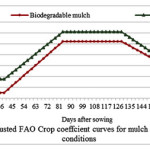 |
|
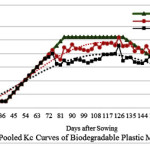 |
|
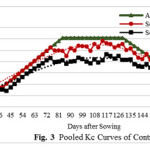 |
|
The comparison of Kc curves for biodegradable plastic mulch and control as per FAO Kc and sensor based Kc at I2 and I1 differed considerably during both years. Sensor based Kc ini, Kc-dev, Kc-mid and Kc-end were lower by 11.58%, 9.13%, 30.04% and 11.58% and 8.42%, 5.63%, 12.99% and 0.25% than FAO adjusted values for I2 and I1, respectively for biodegradable plastic mulch. Whereas, it were lower by 24.51%, 21.10%, 29.27% and 16.20% and 5.32%, 8.98%, 13.21% and -1.47% than FAO adjusted for I2 and I1, respectively for control. Adjusted FAO Kc overestimated ETc at all growth stages during two consecutive years. A considerable deviation in pooled adjusted FAO and sensor based Kc for biodegradable plastic mulch over control is observed in Table 1 and Figure 4 and 5. It was lower by 72.26%, 29.49%, 14.23% and 9.50% and 66.54%, 16.11%, 12.21% and 2.94% than sensor based Kc of no mulch Kc-ini, Kc-dev, Kc-mid and Kc-end, respectively at I1 and I2. Farahani et al. (2008) also reported that during the mid-season stage, the adjusted FAO Kc was 24% higher than the locally developed Kc.
Irrigation water demand was also estimated using Pan ET method using adjusted FAO Kc for respective treatments and compared with water requirement estimated using sensor based ETa values depicted in Table 2. It indicated that cumulative irrigation water estimated by Pan ETc approach was higher of 16.06% & 13.28% than sensor based irrigation at I1 and I2 respectively.
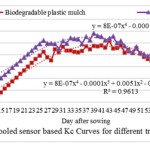 |
|
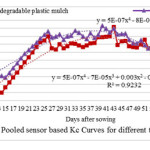 |
|
Table 1: Adjusted FAO Kc and average sensor based Kc for various treatments
|
Cotton crop stage |
Biodegradable plastic mulch |
No mulch |
||||
|
Adj. FAO Kc |
Sensor based Kc |
Adj. FAO Kc |
Sensor based Kc |
|||
|
I1 |
I2 |
I1 |
I2 |
|||
|
Initial stage (20-45 days) |
0.10 |
0.091 |
0.088 |
0.35 |
0.319 |
0.264 |
|
Development stage (45-85days) |
0.57 |
0.54 |
0.52 |
0.79 |
0.77 |
0.62 |
|
Mid stage (85-130 days) |
1.04 |
0.91 |
0.73 |
1.22 |
1.06 |
0.86 |
|
End stage (130-180 days) |
0.425 |
0.449 |
0.40 |
0.49 |
0.496 |
0.41 |
Table 2: Irrigation water requirement estimated by different approaches
|
Irrigation regimes |
Irrigation water (mm) |
|
|
Biodegradable plastic mulch |
||
|
Sensor based ETa |
Pan ETc |
|
|
I1 |
280.31 |
333.96 |
|
I2 |
231.67 |
267.17 |
|
Control |
||
|
I1 |
320.45 |
412.09 |
|
I2 |
257.11 |
329.67 |
Conclusions
Crop coefficient curves for biodegradable plastic mulched cotton was developed for two irrigation regimes. Two sets of Kc curves were developed, sensor based Kc curves as the ratio of measured ETa to ETo and the generalized Kc values published by FAO that were adjusted for local climate for the two years. Sensor based Kc curves not only differed among the two years, but also from the adjusted FAO Kc values. Biodegradable plastic mulch reduced Kc-ini, Kc-dev, Kc-mid and Kc-end values by 72.26%, 29.49%, 14.23% and 9.50% and 66.54%, 16.11%, 12.21% and 2.94% over control at 1.0 IW/ETc and 0.8 IW/ETc respectively. Overestimation of seasonal ETc using adjusted FAO Kc values, cautioning against their blind application without some verification.
References
- Allen, R., Pereira, L. A., Raes, D. and Smith, M. Crop evapotranspiration. FAO Irrigation and Drainage Paper. No. 56 (1998).
- Doorenbos, J. and Pruitt, W.O. Guidelines for predicting crop water requirements. FAO-ONU, Rome, Irrigation and Drainage Paper 24 (rev.) (1977).
- Farahani, J., Oweis, T. Y. and Izzi, G. Crop coefficient for drip-irrigated cotton in a Mediterranean environment. Irrigation science. 26 (5):375-383 (2008).
CrossRef - Fereres, E.; Goldfien, R. E.; Pruitt, W. O.; Henderson, D. W. and Hagan, R. M. The irrigation management program: A new approach to computer assisted irrigation scheduling. of irrigation scheduling for water and energy conservation in the 80s ASAE, St. Joseph, Michigan.:202-207 (1981).
- Hunsaker, J., Pinter, P. J., Barnes, E. M. and Kimball, B. A. Estimating cotton evapotranspiration crop coefficients with a multi spectral vegetation index. Irrig. Sci. 22(2): 95–104 (2003).
CrossRef - Jensen, M. E., Burman, R. D. and Allen, R.G. Evapotranspiration and irrigation water requirements. ASCE Manual No 70 (1990).
- Wright, L. Recent developments in determining crop coefficient values. Proc. 1979 Irrig. and Drain Div. Spec Conf. ASCE. New York, N.Y.: ASCE.:161–162 (1979).
- Wright, L. Crop coefficient for estimates of daily crop evapotranspiration. In: Proc. ASAE Irrig. Scheduling Conf. St. Joseph, MI: ASAE.:18–26 (1981).
- Wright, J. L. New evapotranspiration crop coefficients. J. Irrig. Drain. Div. ASCE. 108(1):57–74 (1982).






